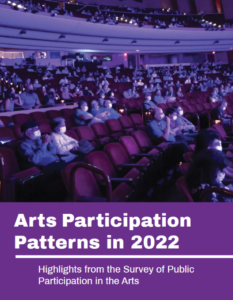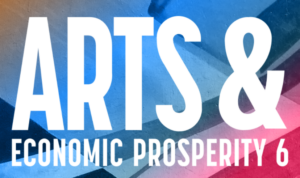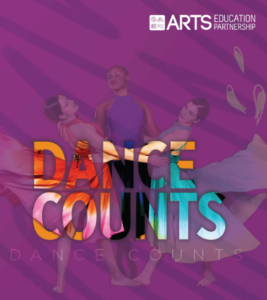November
2023
November 1, 2023
From the Field
National Arts Participation Surveys
 The National Endowment for the Arts has published two analyses of the survey measuring arts participation during the pandemic. Arts Participation Patterns in 2022: Highlights from the Survey of Public Participation in the Arts and Online Audiences for Arts Programming: A Survey of Virtual Participation amid COVID-19 examine arts participation in-person and online, respectively. The Arts Participation Patterns analysis details participation rates by type of arts activity and shows that overall participation has had a slight decrease over the past five years. Virtual participation stayed consistently high, as 82% of respondents engaged in some type of digital arts and culture activity. Each report also presents demographic breakdowns of participants.
The National Endowment for the Arts has published two analyses of the survey measuring arts participation during the pandemic. Arts Participation Patterns in 2022: Highlights from the Survey of Public Participation in the Arts and Online Audiences for Arts Programming: A Survey of Virtual Participation amid COVID-19 examine arts participation in-person and online, respectively. The Arts Participation Patterns analysis details participation rates by type of arts activity and shows that overall participation has had a slight decrease over the past five years. Virtual participation stayed consistently high, as 82% of respondents engaged in some type of digital arts and culture activity. Each report also presents demographic breakdowns of participants.
Arts and Economic Prosperity Study 6 (AEP6)
 Americans for the Arts recently released its sixth Arts & Economic Prosperity study (AEP6), an economic and social impact study of the nation’s nonprofit arts and culture industry. AEP6 provides detailed findings on arts and culture for 373 regions across the United States and Puerto Rico. Study highlights include that in 2022, nonprofit arts and culture organizations and their audiences generated over $151 billion in economic activity. This economic activity supports 2.6 million jobs, generates over $29 billion in tax revenue and provides over 100 billion in personal income to residents.
Americans for the Arts recently released its sixth Arts & Economic Prosperity study (AEP6), an economic and social impact study of the nation’s nonprofit arts and culture industry. AEP6 provides detailed findings on arts and culture for 373 regions across the United States and Puerto Rico. Study highlights include that in 2022, nonprofit arts and culture organizations and their audiences generated over $151 billion in economic activity. This economic activity supports 2.6 million jobs, generates over $29 billion in tax revenue and provides over 100 billion in personal income to residents.
AEP6 is the first of the arts and economic prosperity studies to expand beyond economic and financial data and look at the overall well-being of communities and the importance of affirming spaces for communities that identify as Black, Indigenous and/or people of color (BIPOC) and African, Latin, Asian, Arab or Native American (ALAANA). AEP6 includes highlights, takeaways and deeper dives into the methodology as well as links to previous AEP studies.
2023 Compounding Crises: Snapshot Survey
Theatre Communications Group has just released the results of its 2023 survey of 171 theatres. 2023 Compounding Crises: Snapshot Survey provides an account of how theatres are responding to a postpandemic arts environment across five areas: budgeting, current state of existence, actions taken, challenges and priorities. Initial results suggest that 55% of responding theatres had budgeted for a deficit in fiscal year 2024, which is a small decrease from the previous fiscal year, and that current planning centers around reducing production budgets, addressing the rising cost of labor and materials and prioritizing funding. Additional comments from survey participants are included in the full report.
Arts Count
Dance Counts is the newest edition to the Arts Education Partnership series, The Arts Count. The series showcases special reports to illustrate the many benefits of arts education, focusing on music, visual arts, theatre and dance. The special reports show that the arts have a significant impact on students’ understanding of their identity and culture and that they contribute to learning, motor and early development skills.
is the newest edition to the Arts Education Partnership series, The Arts Count. The series showcases special reports to illustrate the many benefits of arts education, focusing on music, visual arts, theatre and dance. The special reports show that the arts have a significant impact on students’ understanding of their identity and culture and that they contribute to learning, motor and early development skills.
Dance Counts cites research from studies that explore the importance of dance in student academic and personal growth. Dance enhances communication and dance education supports language, literacy and motor skill learning while helping students to develop a sense of identity, personal agency and connection with community.
California Statewide Access to Arts Funding
The California Arts Council (CAC) has just released a comprehensive field scan of statewide access to arts funding with a focus on racial and geographic equity: Equity Challenges in California’s Arts Ecosystem. The field scan consists of four components that provide an overview of statewide nonprofit arts funding (prepared by the National Assembly of State Arts Agencies) and three portraits of arts ecosystems in Fresno, Imperial County and South Los Angeles. The complete report offers eight findings, including that arts access can vary substantially the hyperlocal level, that resources for the arts are distributed inequitably and that the CAC’s grants are more equitably distributed than other sources of contributed income.
In this Issue
From the President and CEO
State to State
- U.S. Virgin Islands: Folklife Festival 2023
- Virginia: Passport Program Partnership with the Virginia Department of Health
Legislative Update
The Research Digest
Announcements and Resources
More Notes from NASAA
SubscribeSubscribe
×
To receive information regarding updates to our newslettter. Please fill out the form below.
